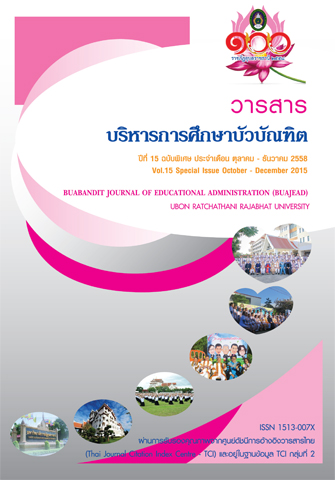รูปแบบการจัดการศึกษาทางเลือกในสถานศึกษาขั้นพื้นฐาน
Main Article Content
Abstract
การวิจัยในครั้งนี้มีวัตถุประสงค์ คือ 1) เพื่อศึกษาสภาพปัจจุบัน ปัญหาและความต้องการจัดการศึกษา ทางเลือกในสถานศึกษาขั้นพื้นฐาน โดยการสำรวจความคิดเห็นของผู้บริหารสถานศึกษา จำนวน 242 คน และ ศึกษาดูงานกรณีศึกษาสถานศึกษาที่จัดการศึกษาทางเลือกประสบผลสาเร็จ 3 แห่ง เพื่อกำหนดองค์ประกอบ ของรูปแบบ และประเมินองค์ประกอบ โดยผู้เชี่ยวชาญ จำนวน 9 คน 2) เพื่อสร้างรูปแบบการจัดการศึกษาทางเลือก ในสถานศึกษาขั้นพื้นฐาน ตามองค์ประกอบที่ได้ในขั้นตอนที่ 1 และประเมินองค์ประกอบของรูปแบบ โดยผู้เชี่ยวชาญ จำนวน 15 คน และ3) เพื่อนำเสนอและประเมิน ความเหมาะสม ความเป็นไปได้ และความเป็นประโยชน์ของ รูปแบบ โดยการประชุมสัมมนาอิงผู้เชี่ยวชาญ จำนวน 21 คน การวิเคราะห์ข้อมูลใช้สถิติร้อยละ ค่าเฉลี่ย ส่วนเบี่ยงเบนมาตรฐาน และการวิเคราะห์เนื้อหา
ผลการวิจัยพบว่า
1. ผลศึกษาสภาพปัจจุบันปัญหาและความต้องการจัดการศึกษาทางเลือกในสถานศึกษาขั้นพื้นฐาน จากการสอบถามความคิดเห็นผู้บริหารสถานศึกษา พบว่า สภาพการปฏิบัติ โดยรวมอยู่ในระดับปานกลาง สภาพปัญหามากที่สุด คือ ปัญหาด้านความประพฤติ รองลงมา คือ ปัญหาด้านการเรียน ส่วนความต้องการ โดยภาพรวมอยู่ในระดับมาก เมื่อพิจารณาเป็นรายด้าน พบว่า ด้านหลักการและจุดมุ่งหมาย มีค่าเฉลี่ยมากที่สุด รองลงมาคือ ด้านการบริหารและการจัดการ ส่วนด้านการจัดการเรียนรู้มีค่าเฉลี่ยน้อยที่สุด
2. รูปแบบการจัดการศึกษาทางเลือกในสถานศึกษาขั้นพื้นฐาน พบว่า มี 5 องค์ประกอบหลัก 47 องค์ประกอบย่อย โดยองค์ประกอบหลักมีสาระสำคัญของ ดังนี้ คือ 1) ด้านหลักการและจุดมุ่งหมาย ให้ความสำคัญกับหลักความเสมอภาค กระจายและให้โอกาสทางการศึกษา หลักการบูรณาการ หลักการยืดหยุ่น และหลากหลาย และหลักการมีส่วนร่วมของชุมชน โดยมีจุดมุ่งหมายเพื่อให้ผู้เรียนมีความรู้ ทักษะและคุณลักษณะ อันพึงประสงค์ตามหลักสูตร 2) ด้านหลักสูตร เน้นให้มีความหลากหลาย บูรณาการและเชื่อมโยงกับสถานประกอบการ เพื่อให้สามารถนาไปใช้ในการประกอบอาชีพและการดารงชีวิตประจำวัน 3) ด้านการจัด การเรียนรู้ เน้นการจัด การเรียนรู้ให้สอดคล้องกับความสนใจ ความแตกต่างระหว่างบุคคล โดยการปฏิบัติจริง 4) ด้านการวัดและประเมินผล เน้นการประเมินให้ครอบคลุมทั้งทักษะ ความรู้ และการมีคุณธรรมจริยธรรม ตามสภาพจริง โดยเครื่องมือ ที่หลากหลายสอดคล้องเหมาะสม 5) ด้านการบริหารและการจัดการ เน้นการพัฒนาครูและบุคลากรให้มีความรู้ เข้าใจในการจัดการศึกษาทางเลือก จัดหาสื่อเทคโนโลยีที่ทันสมัยสร้างแหล่งเรียนรู้อย่างหลากหลาย และประสาน ความร่วมมือกับชุมชน
3. ผลการนาเสนอและประเมินความเหมาะสม ความเป็นไปได้ และความเป็นประโยชน์ของ รูปแบบ พบว่า โดยภาพรวมทุกด้าน อยู่ในระดับมากที่สุด
The Model for Providing Alternative Education in Basic Education School
The objectives of this research were 1) to study the present, problems and needs of alternative education in basic education school. In the opinion of 242 school administrators and a case study was conducted in three schools. Then continue to monitor and evaluate the main component elements of the model was considered by nine experts. 2) to construct of the model was considered by fifteen experts. 3) The presentation and evaluation of the model was done by connoisseurship of twenty one experts. The statistics used for data analysis are percentage, mean, standard deviation and content analysis.
The research findings were as follows:
1. The current state of the providing alternative education in the basic education in overall were at moderate level. As for individual aspects, it was found that the aspects with a maximum value were behavior and academic problems. The demand in overall were at higher level. As for individual aspects, it was found that the aspects with a maximum value were the principles and aims, followed by the administration and management. the aspects with a minimum value was the learning management.
2. The construct of a model revealed that the model was composed of five main elements, forty seven elements. The main elements were as follow. 1) the principles and objectives, consisting of the equality, the distribution and educational opportunities, the integration, the flexibility and variety and the involvement of the community. It aimed to provide students with knowledge, skills and desirable characteristics. 2) the curriculum, consisting of the diversity, the integration and linked to the establishment which could be applied to professionals and everyday life. 3) The learning management, consisting of the learning to comply with attention, the differences between individuals by learning by doing. 4) the evaluation, emphasized on assessing the skills, knowledge and ethic authentic by variety of tools with reasonably consistent. 5) the administration and management, emphasized on to develop teachers and staff to have knowledge, understanding of alternative education, supply advanced technology, create a variety of sources and collaborate with the community
3. The results of the presentation and evaluation of the model in the study, it was found that suitability, possibility and usefulness were at the highest level in all items.
